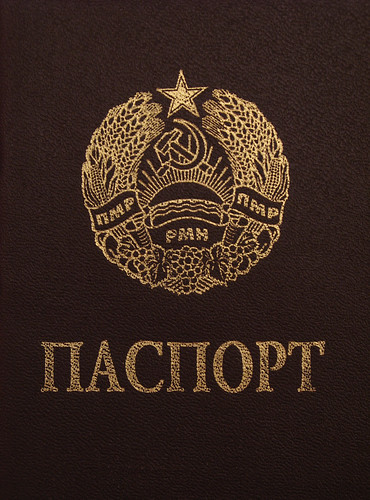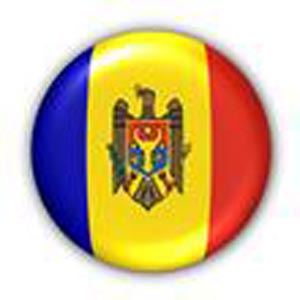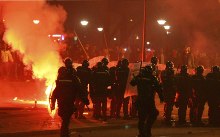 The
escalation of tensions between Moldova and the break-away Transnistria
region is causing concern in the EU and neighbouring Romania. Growing
dispute between parties started by unilateral actions by both parties
during this Spring. First Moldova established migration control of
citizens in six checkpoints, second Transnistria started to mark border
in in the sc Security Zone or line of demarcation after the Transnistrian war (1992).
The
escalation of tensions between Moldova and the break-away Transnistria
region is causing concern in the EU and neighbouring Romania. Growing
dispute between parties started by unilateral actions by both parties
during this Spring. First Moldova established migration control of
citizens in six checkpoints, second Transnistria started to mark border
in in the sc Security Zone or line of demarcation after the Transnistrian war (1992). The present round of changes started already on March 2013 in particular, the Republic of Moldova unilaterally decided to establish migration control of citizens in the six checkpoints: Gyrbovets (Novye Aneny), Khadzhimus (Kaushany), Dubossary, Kriulyany, Rezina, Seneteuka (Floreshty) without proper coordination at the bilateral or multilateral international level and within the framework of the Joint Control Commission. (Source PMR FA) The decision imposes limitations on the citizens of Russia, living in Transnistria (about 150 thousand people) and forming one-fourth of Transnistria’s population. The Moldovan authorities said they did it in order to establish order on the future eastern border of the European Union, which Moldova plans to join.
In 2011 presidential elections President Igor Smirnov, who had been in power since Transnistria declared independence in 1990, was replaced by opposition MP and former speaker of the Supreme Council Yevgeny Shevchuk. Earlier President Shevchuk, made a startling proposal to move the region’s legislature, the Supreme Council, from Tiraspol to the territory’s second-largest city, Bender. The choice of Bender was clearly symbolic: the city is the site of one of the bloodiest battles in the 1990s war that ended with Transnistria declaring independence from the Republic of Moldova. The proposed move would also take the significant step of carrying Transdniester’s political center of gravity across the Dniester River, which geographically separates the bulk of the breakaway region from Moldova proper. Bender is one of the few regions on the Dniester’s western bank that is under Transdniester's de facto jurisdiction. Bender also lies within the security zone established after the war, a narrow strip that includes Transdniestrian and Moldovan exclave territories on both banks of the river. The terms of the 1992 cease-fire agreement prohibit either party from taking actions that would deliberately aggravate tensions between the two sides. In this light, the Bender proposal has been interpreted by some as the kind of land grab that has been seen in other territorial conflicts in the former Soviet Union and the post-war Balkans. Supreme Council lawmakers rejected the proposal on May 23, voting to pass a resolution stating that the Transdniestrian parliament should remain in the territory’s de facto capital, Tiraspol.

- Graphics credit: RFE/RL
In 1992 Moldova and Transdnistria fought a brief, bitter war which the separatists won, with the assistance of a contingent of locally-based Russian troops left over from the Soviet Red Army. Cease fire left Russian troops in place as peacekeepers and Transdnistria has since then acted de facto as independent – although not recognized – state. Transnistria region broke away in Soviet times because it feared Moldova would unite with Romania. Most of Moldova was once part of its western neighbour.
Most of Moldova was once part of Romania and now there are growing social forces in Moldova seeking reunification with its western neighbour for nationalist reasons and as an easy path to EU membership. Already between 10% and 20% of Moldovans have Romanian, and by extension EU, passports. The fear of Romanian expansionism frightens Transnistria away from reconciliation, while the “Kosovo precedent” gives its arguments for independence more weight. In 2009 Romanian President Traian Basescu told the Romanian parliament that he would fast-track Moldovans for Romanian citizenship following riots in the Moldova (Source DW) . Fast-tracking citizenship to some 1m people next door in Moldova, in effect giving EU citizenship to a quarter of the population of Europe’s poorest state.
Transnistrian population - about 555,000 people (2009). 90% of the population of Transnistria are citizens of the unrecognized Transnistria. Transnistrians have double or triple citizenship, including:
a) Citizens of Moldova - around 300,000 people (including double citizens of Russia (around 170,000, or EU states (around 80%) Romania, Bulgaria, Czech Republic)
b) Citizens of Russia - around 150,000 people (including around 15,000 - double the citizens of Belarus, Israel, Turkey); without quantity of dual citizenship Russia and Moldova (around 20,000)
c) Citizens of Ukraine - around 100,000 people. There are around 20,000-30,000 people with dual citizenship (Moldova and Ukraine, or Russia and Ukraine), or triple citizenship (Moldova, Russia and Ukraine). They are considered in the quantity of citizens of Ukraine and finally
d) persons without citizenship - around 20,000-30,000 people.
In my opinion even without international recognizion Transnistria meets the requirements for sovereign statehood under international law, as it has a defined territory, a population, effective elected authority, and the capability to enter into international relations. It is currently seeking international recognition of its de facto independence and statehood.
Frozen talks
Moldova and Transnistria have been close for solution by widely agreed sc “Kozak plan” which still is valid for further examination.
In the Spring 2003 Dimitry Kozakin – a special envoy of Russian President Putin – started to broke deal between local stakeholders and finaally proposed on the creation of an assymmetric federal Moldovan state, with Moldova holding a majority and Transnistria being a minority part of the federation. Known as "the Kozak plan", it did not coincide with the Transnistrian position, which sought equal status between Transnistria and Moldova, but gave Transnistria veto powers over future constitutional changes; this encouraged Transnistria to sign it. However when the plan was ready and preliminary agreed to sign on November 2003 the Western powers put some pressure towards Moldova leading to President Voronin’s rejection to sign.
 August
2008 was the turning point in negotiation process. Conflict in Georgia
was in background when Russian President Medvedev first held talks with
Moldova’s President Voronin and later with Transdnistria’s leader
Smirnov. 5+2 format was replaced with 1+2 format including Moscow as
mediator, Chisinau and Tiraspol as the parties of conflict. The basic
elements of new deal are probably similar like in Kozak plan I. The
price of reunion will be high to Moldova because probably federation
form with strong minority or veto rules would neutralize Moldova’s
foreign policy related integration towards EU and Nato. Higher price for
Moldova could be even stronger sovereignty of Transdnistria with thread
that also other autonomous territory of Moldova – namely Gagauz region –
would follow the steps of Transdnistria; it is expected that the
demands of transforming Gagauzia region from autonomy to republic will increase.
August
2008 was the turning point in negotiation process. Conflict in Georgia
was in background when Russian President Medvedev first held talks with
Moldova’s President Voronin and later with Transdnistria’s leader
Smirnov. 5+2 format was replaced with 1+2 format including Moscow as
mediator, Chisinau and Tiraspol as the parties of conflict. The basic
elements of new deal are probably similar like in Kozak plan I. The
price of reunion will be high to Moldova because probably federation
form with strong minority or veto rules would neutralize Moldova’s
foreign policy related integration towards EU and Nato. Higher price for
Moldova could be even stronger sovereignty of Transdnistria with thread
that also other autonomous territory of Moldova – namely Gagauz region –
would follow the steps of Transdnistria; it is expected that the
demands of transforming Gagauzia region from autonomy to republic will increase. There
is an opinion, that the Transnistrian conflict will be resolved if
Moldova joins the Eurasian Economic Union (EurAsES or EAEC)where Moldova
now has an observer status: “The Transnistrian conflict is soluble.
When we all come into the EurAsES, all questions will be resolved”.
However this option seems to be unrealistic. A new approach (joint
initiative of Russia and Germany, Meseburg, 2010) by the EU and Russia
to resolve the conflict could be the setting up of a joint Political and
Security Committee (EU-R-PSC) at minister level.. Transnistria thereby
became a test case for future cooperation with Russia.
There
is an opinion, that the Transnistrian conflict will be resolved if
Moldova joins the Eurasian Economic Union (EurAsES or EAEC)where Moldova
now has an observer status: “The Transnistrian conflict is soluble.
When we all come into the EurAsES, all questions will be resolved”.
However this option seems to be unrealistic. A new approach (joint
initiative of Russia and Germany, Meseburg, 2010) by the EU and Russia
to resolve the conflict could be the setting up of a joint Political and
Security Committee (EU-R-PSC) at minister level.. Transnistria thereby
became a test case for future cooperation with Russia.

 Twitter revolution did not change government in Moldova but created big drama instead including a couple of conspiracy theories and “fast-track” mini enlargement of EU with one million new EU citizens while same time Moldova possibly losing a quarter its citizens. So a relatively small improvised demonstration can lead its (mis)use for possible purposeful utilization of multidimensional aims of different players.
Twitter revolution did not change government in Moldova but created big drama instead including a couple of conspiracy theories and “fast-track” mini enlargement of EU with one million new EU citizens while same time Moldova possibly losing a quarter its citizens. So a relatively small improvised demonstration can lead its (mis)use for possible purposeful utilization of multidimensional aims of different players.




 significance as the new leadership will be the counterpart during period after EP elections influencing e.g. enlargement, partnership and security questions.
significance as the new leadership will be the counterpart during period after EP elections influencing e.g. enlargement, partnership and security questions. Transdnistrian question
Transdnistrian question 

 will probably continue in 2+1 format (Moldova and PMR as parties, Russia mediator), possible result will be delivered to official “western backed” 5 (Moldova/PMR, Russia, Ukraine, OSCE)+2 (U.S. and EU) process.
will probably continue in 2+1 format (Moldova and PMR as parties, Russia mediator), possible result will be delivered to official “western backed” 5 (Moldova/PMR, Russia, Ukraine, OSCE)+2 (U.S. and EU) process.
 Recently I was searching some information about Transnistria - aka Pridnestrovie - and found a probably official
Recently I was searching some information about Transnistria - aka Pridnestrovie - and found a probably official